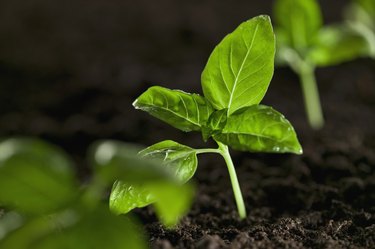
CO2, also known as carbon dioxide, is a necessary element to plant life. Plants absorb carbon dioxide out of the atmosphere and use it to complete photosynthesis, making them very beneficial as "air cleaners." Plants then release oxygen back into the air. But, with ever-rising amounts of carbon and other greenhouse gases in our atmosphere, a concern has arisen as to how much CO2 plants can actually take.
Toxicity
Video of the Day
It takes extremely high concentrations of carbon dioxide to affect plant life. After an extended period of time when exposed to 10,000 ppm (parts per million) of carbon dioxide in the air, some plants begin to show signs of distress. These symptoms can be anything from a 25-percent reduction in yield to zebra striping on the leaves.
Video of the Day
Benefits
Some plants show no toxicity at all to raised CO2 levels, instead thriving. These include poison ivy and some species of honeysuckle vine. The excess CO2 actually affects the plants in a way that makes them grow more vigorously; in closed experiments, rather than showing toxic effects, the vines grew in excess of twice as much throughout a normal growing season. Greenhouse gases like CO2 have this effect on a number of weeds.
Yields
Many plants show more vigor when exposed to slightly elevated CO2 levels. This manifests itself in as much as 25 percent higher produce yields and larger, brighter blooms. The presence of the gas has even been shown to help legumes fix more nitrogen in their roots, enriching the soil.
Note
The amounts of carbon dioxide that would cause toxicity in plants are extremely high, and any plant exhibiting signs of toxicity does so in an environment where CO2 is being introduced intentionally at exaggerated levels. In addition to raised CO2 levels, the plants often have to experience additional stresses in order to show toxicity. If the plants growing in your home or garden are exhibiting reduced yields or striped leaves, eliminate all other possible causes before diagnosing CO2 toxicity.
- Ask a Scientist; Oxygen vs. Carbon Dioxide Use in Plants; Steve Sample
- Taylor Francis Online; Carbon: A Plant Nutrient, Deficiency and Sufficiency; N. Schwartz, et al.; November 2008
- NCBI PubMed; Co2 Crop Growth Enhancement and Toxicity in Wheat and Rice; B. Bugbee, et al.; November 1994
- The Free Library: Pumped-Up Poison Ivy: Carbon Dioxide Boosts Plant's Size, Toxicity
- NCBI PubMed; Long-Term Acclimation of Plants to Elevated Co2 and its Interaction with Stresses; Z. Tuba, et al.; Oct. 2007
- The Many Benefits of Atmospheric Co2 Enrichment; Robert Ferguson
- Weed Science; Rising Atmospheric Carbon Dioxide...; L.H. Ziska, et al.; 2007